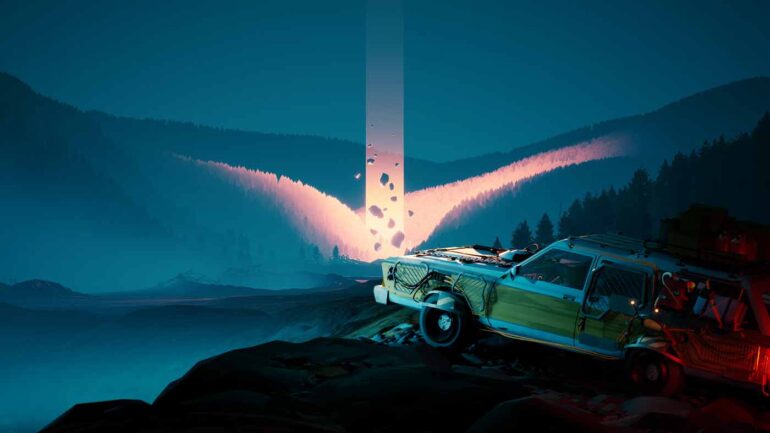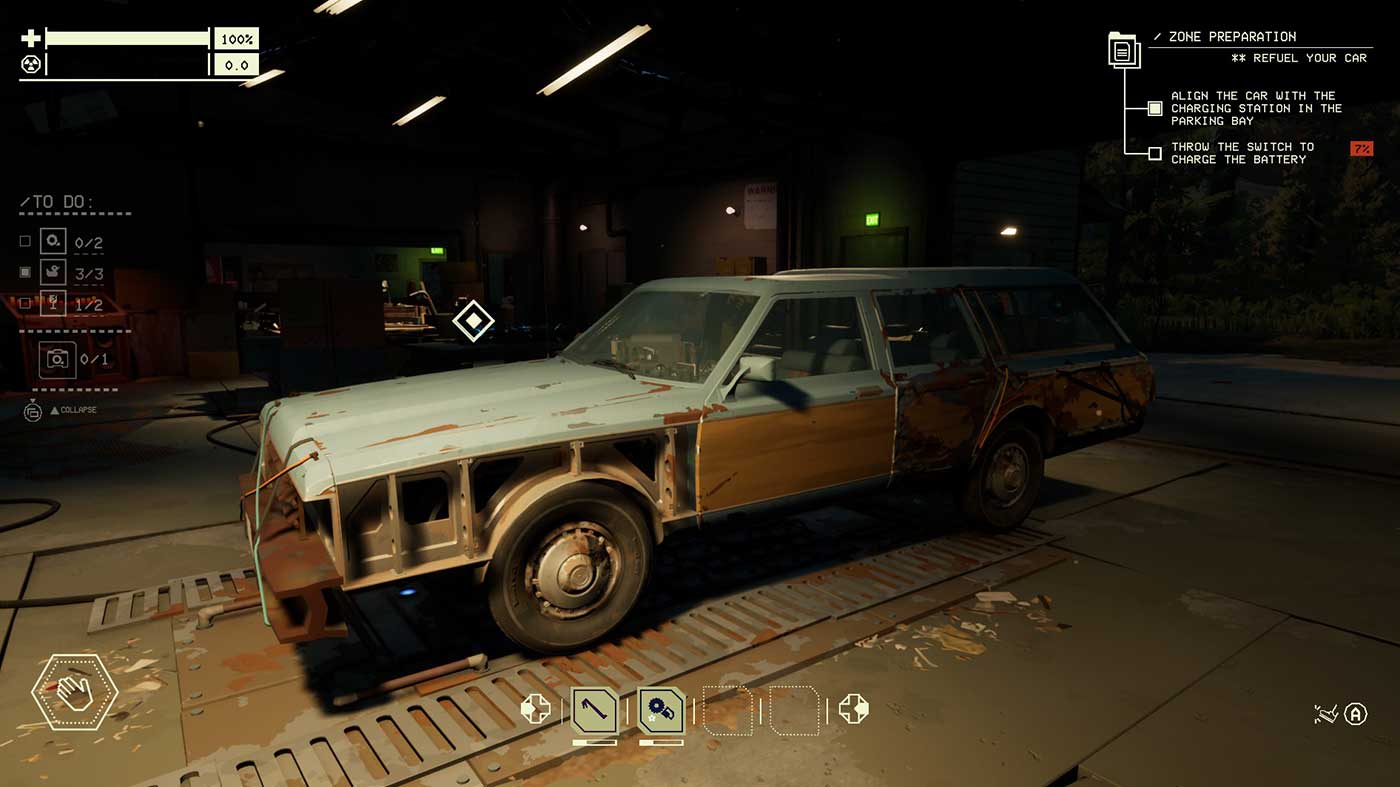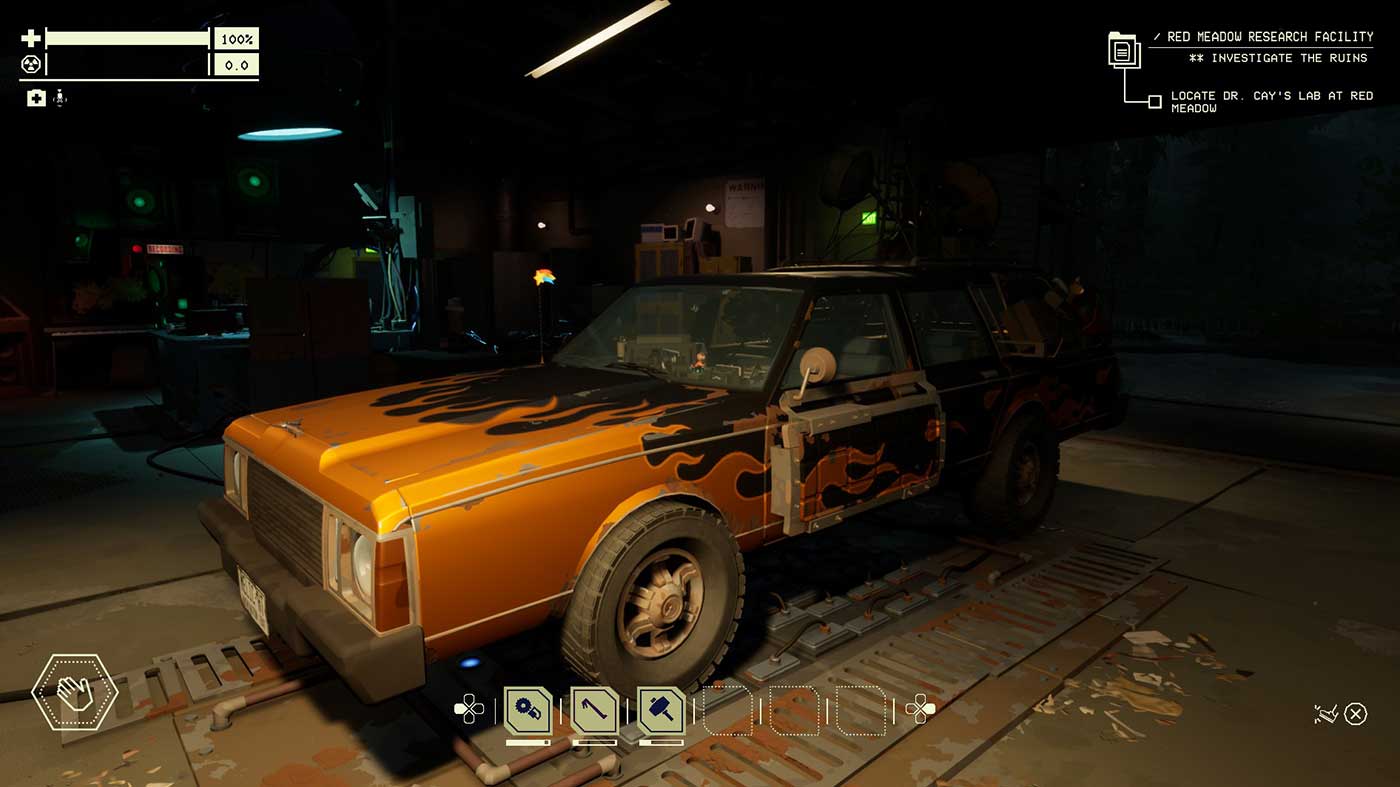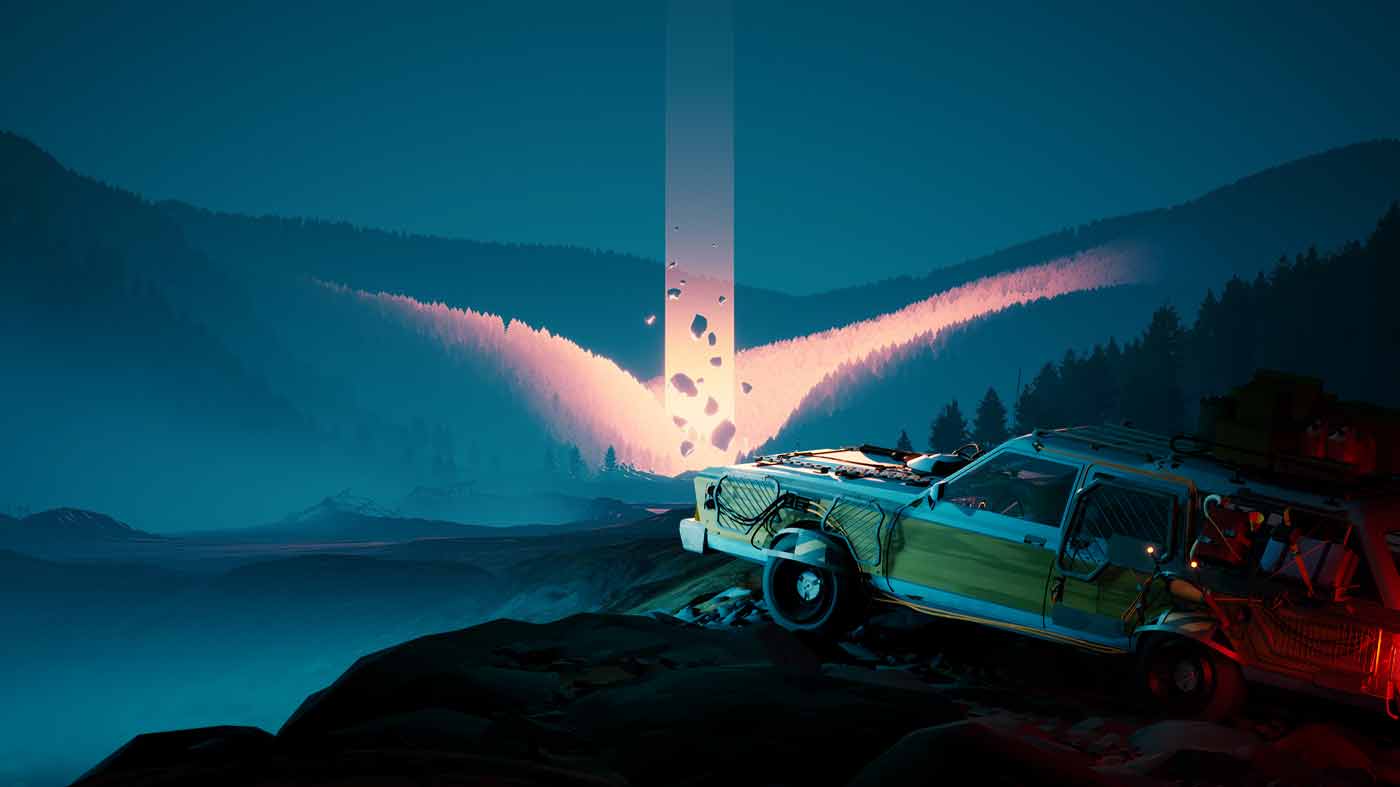If you’ve ever owned a crappy car, I’m sure you know the feeling of constantly trying to keep it running with nothing but duct tape, WD40 and a prayer. Now imagine doing that while fighting for your life in the ever-changing, ever-threatening forests of the American Pacific Northwest and you’ll have a very rough idea of what to expect in Pacific Drive. Ironwood Studios’ debut title is an ambitious intersection of popular genres, but spending several hours behind the wheel of this spooky sci-fi station-wagon simulator has truly been a road trip to remember.
In a scene that is sure to unsettle even the most seasoned Uber employee, Pacific Drive opens with your character following some cryptic delivery instructions down a highway flanked by a dense pine forest and the imposing wall of the mysterious Olympic Exclusion Zone. The solemn beauty of the Pacific Northwest is swiftly interrupted as a massive portal inexplicably appears and unceremoniously sucks you out of your car, dumping you on the wrong side of the wall – the side filled with all manner of otherworldly hazards.
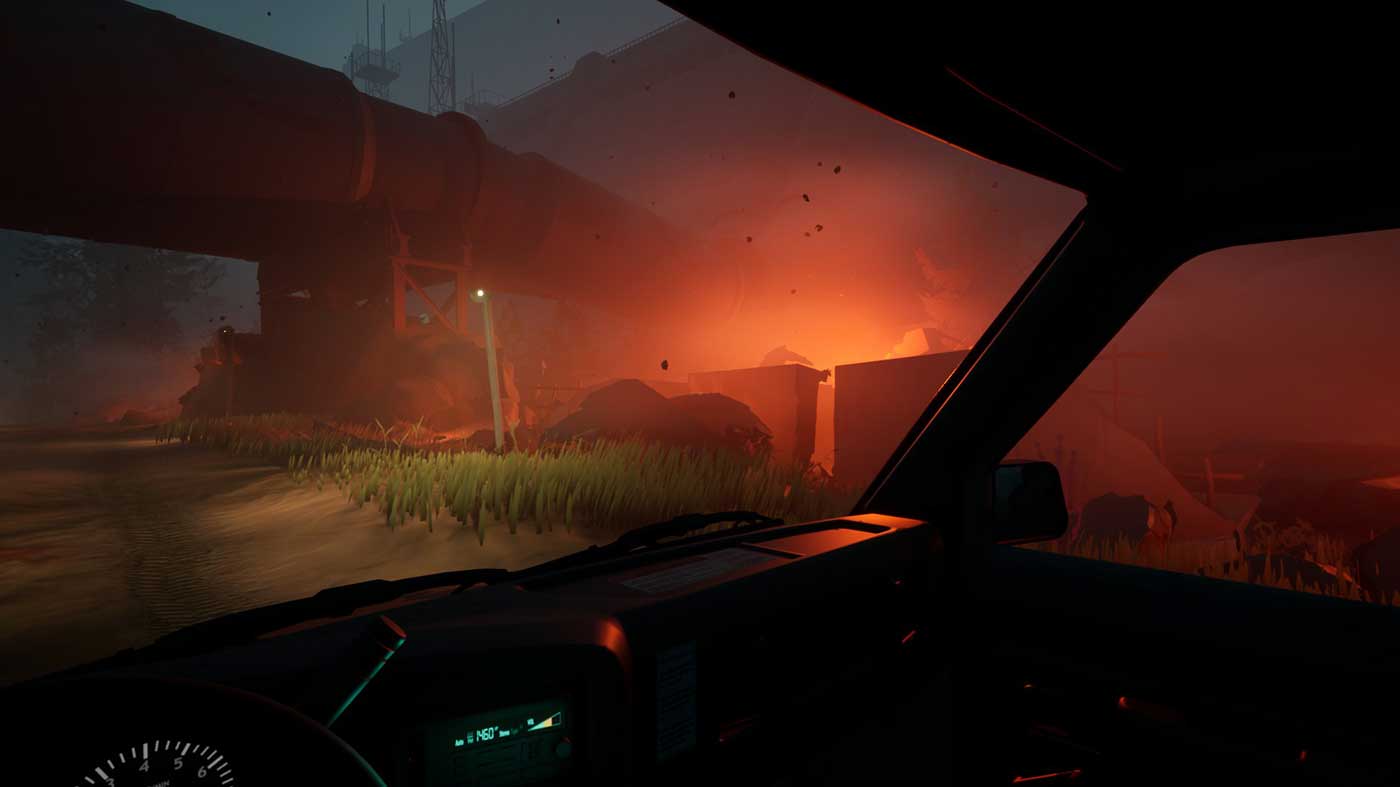
In a mad dash to escape the encroaching spread of radiation, you’ll discover the other hero of this game, a run-down jalopy that’s barely held together by rust and missing several important features, such as a wheel. Beggars can’t be choosers though and after following the instructions of a mysterious voice on the radio, you’ll collect random junk from around the car, fix ‘er up as best you can and narrowly escape to a nearby auto shop, a rare safe zone in the otherwise extremely hostile environment.
After you’ve caught your breath, your new radio friend tells you that the car you found is actually a blessing and a curse. As it happens, the humble looking station wagon is a strange and powerful ‘Remnant’, an object that has been twisted by the paranormal forces of the Olympic Exclusion Zone and one that will eventually drive you mad. On the plus side though, it will allow you to venture deeper into the warped landscape, uncover the mysteries of the zone and maybe even find an escape. So, once you’ve explored the auto shop and your new ride is ready to roll, it’s time to buckle up, set your course and embark on the first of many, many extraordinary expeditions.
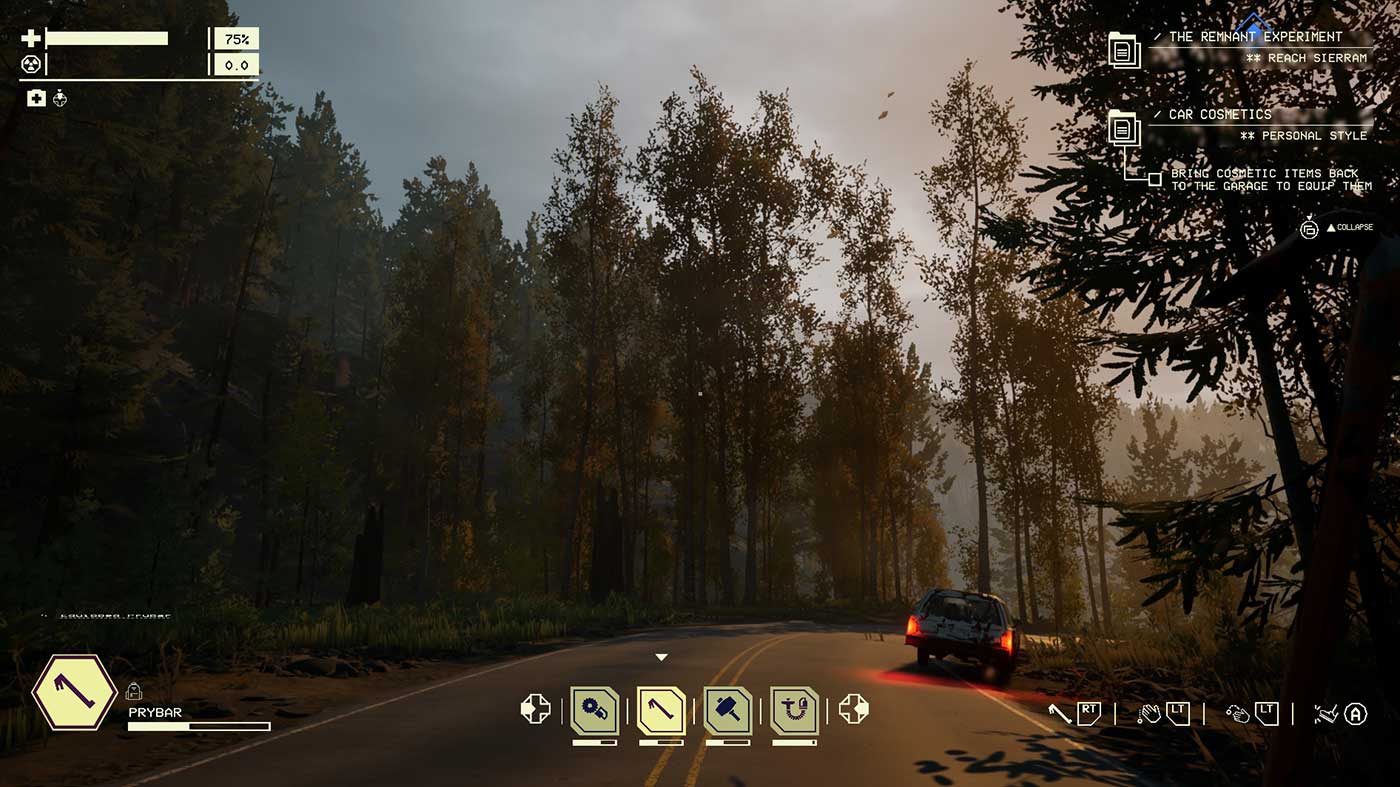
The opening act not only establishes the tone and narrative of Pacific Drive, but it also serves as an introduction to the gameplay loop you can expect over the next 20+ hours. Though it’s described as a ‘first person driving survival game’, I’d definitely throw ‘roguelite’ and ‘crafting’ into the mix of tags. From the auto shop, you’ll use a giant map to plan a route to an objective given to you by one of the handful of NPCs coming in via the radio. You’ll then prepare by tinkering with your car, filling up the fuel tank, charging the battery and stocking up on various tools from a basic crowbar to the panel-chewing Scrapper.
Once you’re on the road you’ll pass through several Junctions, which are large, randomised environments with an entry point, an exit point and a whole bunch of hazardous anomalies between them. Things like electrified pylons that shoot lightning at you, pockets of intense radiation and giant buzz-saws that race menacingly across the road, ready to pulverize unwary drivers. Not to mention a whole bunch of pine trees and boulders, both of which are more than capable of ruining your day.
Given that your car is already a piece of crap, it’ll constantly fall to literal pieces under these conditions. Thankfully, you can use the aforementioned tools to exploit the several wrecked vehicles and abandoned buildings dotted around the map to collect resources, which you can then use to mend your wagon in a sort of post-apocalyptic take on roadside assistance. As you pass through the junctions you’ll also learn to be on the lookout for ‘stability anchors’, glowing orbs that are needed to power the teleporting technology in your passenger seat.
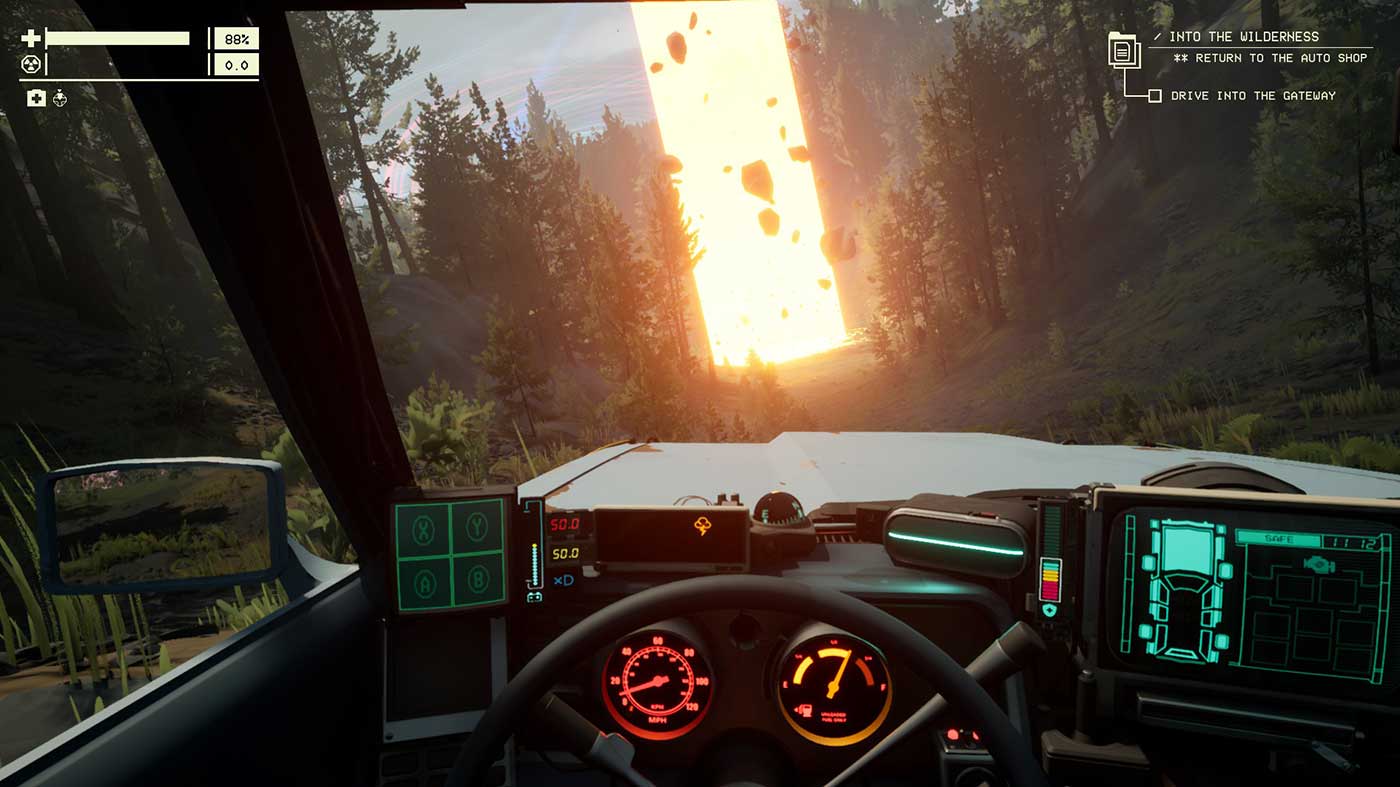
You see, a consequence of the shifting nature of the zone is an instability storm will be hot on your heels as you travel, meaning that there is no time to dilly-dally, and your trip is essentially one-way. After collecting enough power and achieving whatever objective you set out for, firing up the teleporter initiates a race to a pillar of light as the stormfront is pulled to your position, making for a final bit of tension as you speed toward your salvation after phoning in your own potential destruction.
Of course, each successful run (hopefully) comes with new resources to repair and upgrade your car, as well as upgrade your own equipment and the amenities of the shop. The amount of progression options on offer is surprisingly massive and varied. Some enhancements will allow you to travel further into the zone in the pursuit of story and resources, some will help you survive longer on your expeditions, and some will make maintaining and repairing your vehicle easier, all in service of your next run.
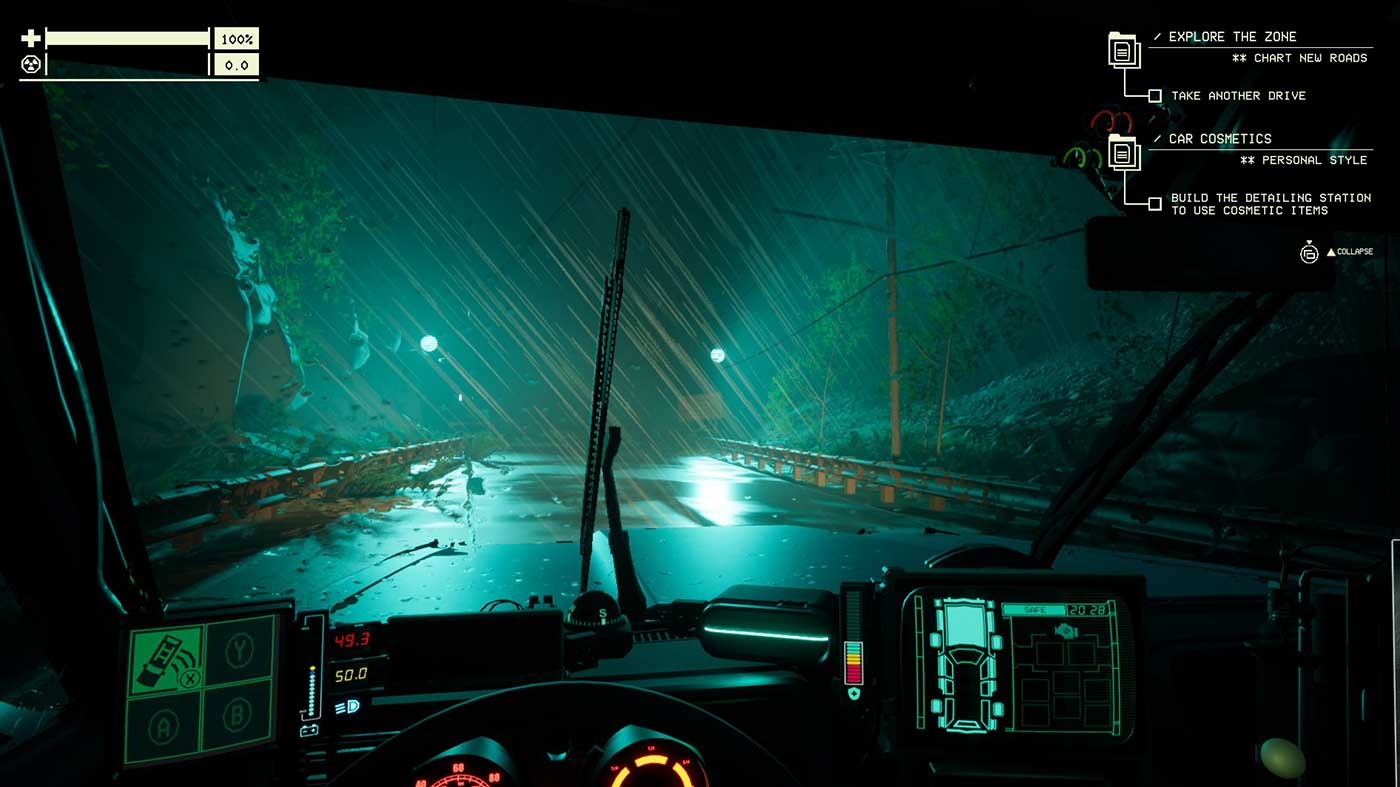
One of Pacific Drive’s strongest points is its atmosphere. Ironwood Studios has done a sensational job at making you really feel parts of this game. Embarking on expedition after expedition always stays exciting because the environments and anomalous hazards feel so oppressive and otherworldly. I was constantly torn between exploring my surroundings for precious resources and tantalising clues, or just getting the hell out of dodge because my ride is already missing a door and I can see an approaching swarm of sticky, acid-spitting orbs looking for real estate on my car bonnet.
I wouldn’t necessarily say that this is a horror game, but there were many moments that genuinely creeped me out or made me jump. I remember one trip where the howling wind ripped through the trees as I scrambled through the pitch black forest in search of a glowing stability anchor, when I finally had it I turned around and was faced with a horde of explosive but otherwise stationary mannequins that had inexplicably appeared directly behind me. The sound effects, lighting, atmosphere, and anomaly design all coalesced into a moment that honestly made my heart skip a beat, one of many similar experiences throughout the game. The vibes here could easily share a Venn diagram with haunted Pacific Northwest forests of Alan Wake 2 or the unsettling dangers of Control.
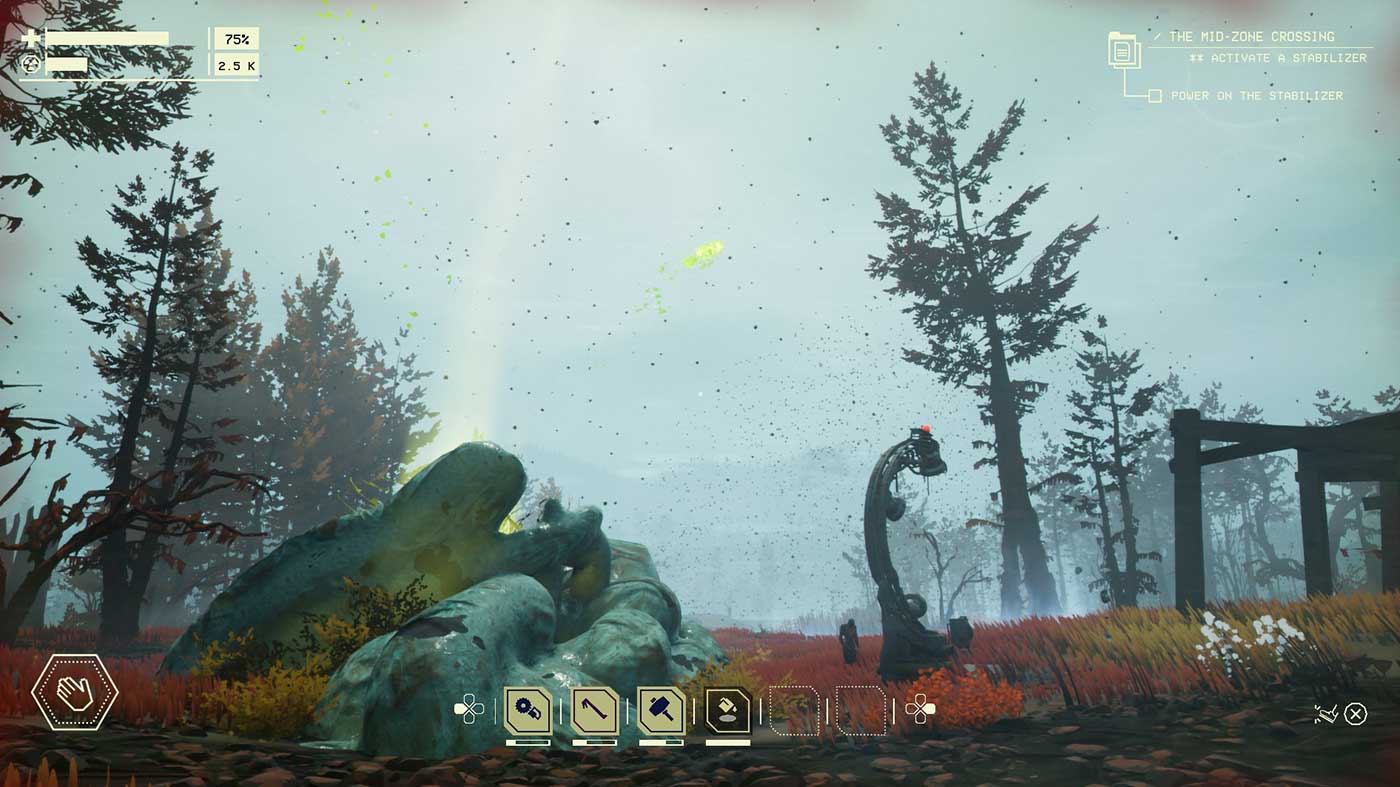
The overall narrative of Pacific Drive will play out through handful of characters you’ll ‘meet’ over the radio. The writing and voice acting of these characters is another strong point in the game and they constantly compelled me to head out on another expedition to uncover the mysteries of the exclusion zone and the people within it. The real hero though, is the station wagon.
I’ve never really been a car guy, but I quickly fell in love with my annoying yet endearing companion and I found myself actually feeling quite bad if I ever let it down. I also found myself getting increasingly exasperated when things went wrong with the car, becoming verbally upset when I’d get a puncture in a just-replaced tire or lose a headlight. When you’re fanging it to the pillar while staring down a deadly hurricane though, integrity indicators all flicking to red and doors flying off around you, the feeling of making it back to the shop thanks to my little wagon that could did nothing but solidify our symbiotic relationship more and more each time.
Though I mostly adored Pacific Drive, there are a few frustrating elements that may impact your experience. I think the biggest barrier for some people will be the UI, in particular the lack of clarity and consistency around certain mechanics. Although a recent pre-launch patch has gone a fair way at fixing some particularly confusing UI elements, I still find myself struggling to understand parts that I feel should be easy. For example, I spent a hefty amount of higher tier resources to unlock the ability to skip certain junctions, but it was never explained how to do it and I still haven’t worked it out.
There are also some inconsistencies across different menus, with something like the workshop offering the very handy feature of automatically crafting higher-tier parts for upgrades if you have the base materials on hand, while other screens force you to go and manually craft parts elsewhere before you can proceed.
A mechanic that sees you car develop random ‘quirks’ that can range from doors opening when you start the engine to serious issues like fuel draining much faster when the headlights are on is similarly novel, but let down by a frustrating guessing game where you have to try and match the cause with the issue from a list of hundreds of options, with no easy way of elimination or keeping track.
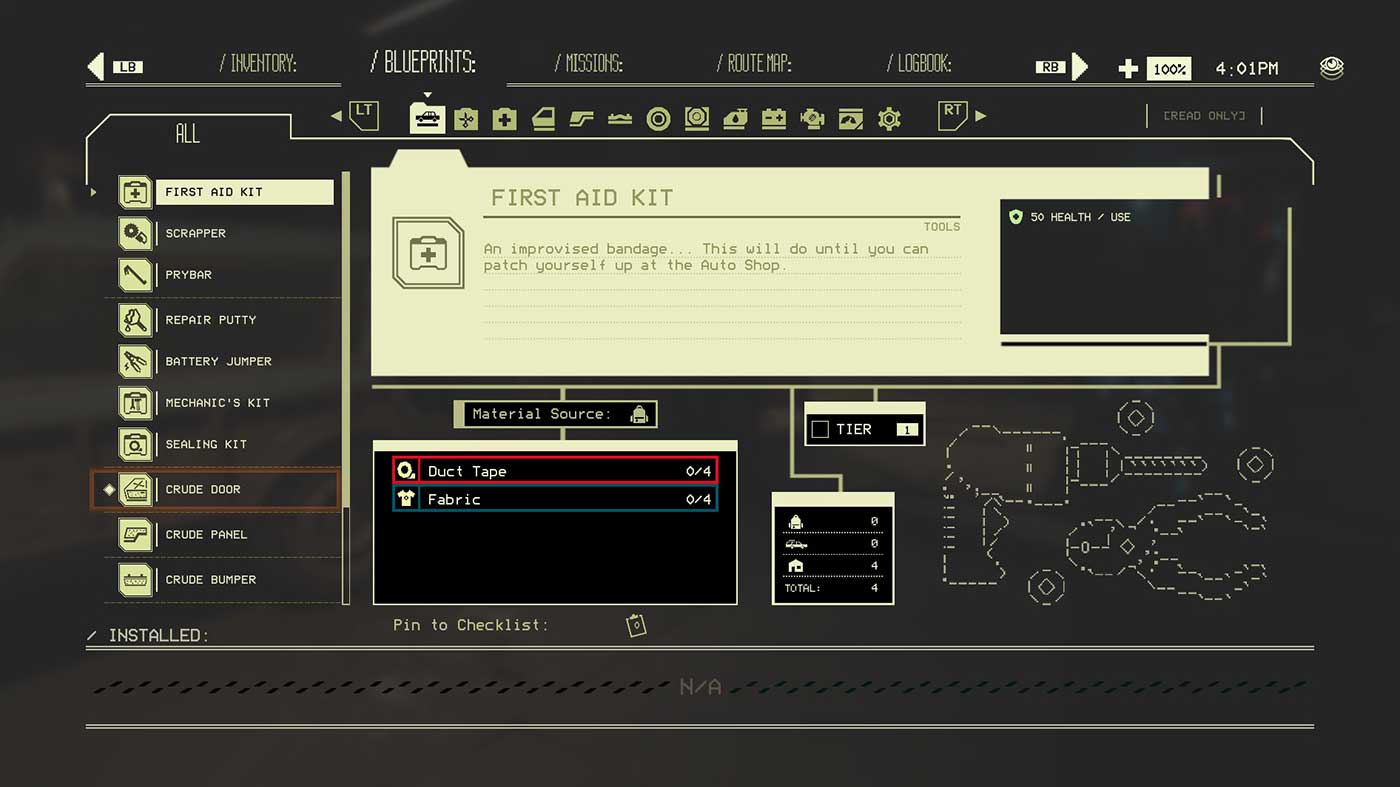
The most egregious complaint I have with Pacific Drive is how the route selection works, namely the lack of clarity around it and how it impacts your progress further into the game. Progression can sometimes feel overly incremental and needlessly gated by the way that you’re forced back to the shop after unlocking new junctions, rather than just letting you continue forward until you decide the risks outweigh the rewards and head back.
Some routes will also lead through several junctions, only to present you with no option other than to enter a dead end. These dead ends have no means of escape or progression and you simply have to abandon your run from the pause menu to return to the shop, completely destroying your car and forfeiting all of the resources you gathered along the way.
Annoyingly, there doesn’t seem to be a way of avoiding this when you initially set your route other than guess work and I lost several 50+ minute runs and hundreds of rare resources to dead ends. Coupled with the inconsistency and scarcity of resources needed for late-game upgrades, progression in the tail end of Pacific Drive can sometimes feel like a chore.


